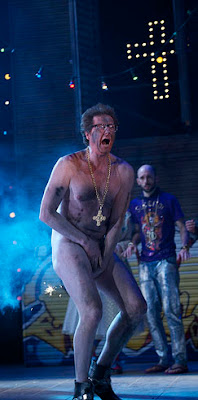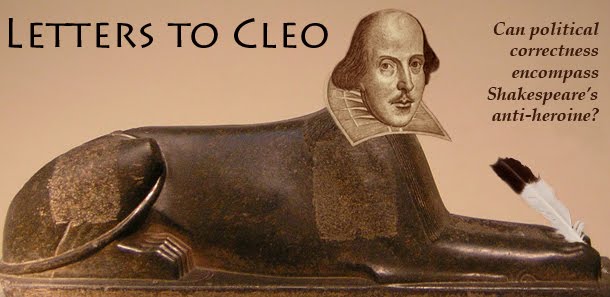 |
| The Word made gay flesh: Stephen Spinella and Michael Esper in iHo. |
In the beginning was the Word, St. John tells us. Only Tony Kushner might add, "And in the middle was the Word. Plus in the end there were a whole lot more Words, too." (He might even whisper, "And they were all made flesh.")
Or so you might guess after seeing (or more importantly, hearing) The Intelligent Homosexual's Guide to Capitalism and Socialism with a Key to the Scriptures (at New York's Public Theater through June 12). That is if that 14-word title, with its implied dialectic of reference, hadn't itself suggested the erudite logorrhea of Kushner's latest play, which runs only about 3 hours and 40 minutes, but which "actually" runs at least twice (or maybe even three times) that length, because many scenes are densely-packed sexta- and septa-logues in which every major character is chattering at once.
But let me say up front: that title is perfect. Even its length is perfect. As for the play - well, I suppose it is imperfect, but only imperfect in the way that Long Day's Journey into Night and Hamlet, Prince of Denmark are; it's over-stuffed and hard to classify and somewhat at odds with its own means. In other words, iHo (as Kushner now refers to it) may not be perfect, but it is certainly great. Probably the greatest play of the millennium, in fact, and perhaps the greatest play since Kushner's own Angels in America (my guess is that it will eventually rank second in his oeuvre after that epoch-defining epic).
Now I know what you're thinking, all you little Rob Kapilows out there: "What makes it so great, Garvey?" Well, to start with, it has a grand theme: the death of the left in America. Actually make that the suicide of the left - the play traces the path toward self-deliverance of one Gus Marcantonio, aging labor organizer and patriarch of a leftish clan from whom he actually asks permission to die. Gus, of course, is merely the latest in a long line of Kushnerian archetype-stereotypes (like Roy Cohn and the Homebody) whom the playwright has used to illumine the internal contradictions of his gi-normous themes; Kushner has always been a kind of dramaturgical moth drawn to the fires of crisis, and with Gus and his offspring he clearly means to shine a light on a social issue we've been trained to never discuss as a "crisis," but which is as far-reaching in its implications and effects as the AIDS crisis, or the civil rights movement, or terrorism in Afghanistan (all of which Kushner has treated in earlier plays). Watching iHo, in fact, you often feel that finally one of our playwrights has dared to point out the invisible political elephant that has been standing in the American living room for something like two decades.
 |
| Kushner in his ad for Gap. |
Of course Kushner would never abbreviate anything - that way, to his mind, lies the disappearance of the Word (and thus the world). Instead he all but revels in his own happily reactionary intellectual capacities: the symbols here are simultaneously bald and yet almost too complex to parse (at least at first reading), and the the ramifications of the conflicts seem to explode in our heads even as we attempt to track them. We sense puns layered on puns, both explicit and implicit, and the very structure of the play constitutes a kind of argument with itself. But then Kushner explains at the top of the evening that he hopes to engender the dizzy sense of intellectual vertiginousness that George Bernard Shaw conjured in his most contrarian plays (or in his enormous Intelligent Woman's Guide to Capitalism and Socialism) - that sensation, rather like being on "poppers or speed or E" (as the playwright puts it), that puts you once again right where Kushner wants you - on the threshold of revelation.
Only Kushner's trying to do this without any angelic interventions, or talking home appliances, or even the strangely incantatory direct address of Homebody/Kabul. Because this time he is decidedly not writing a fantasia; there's no more "magic" in his "realism"; instead he is doing his own variation on that warhorse of the twentieth-century stage, the American Family Drama. And he plays strictly by its rules: nothing crashes through the (low) ceiling of the set, and long-lost ancestors stay firmly in their photos on the mantle; the action - which even observes most of the classical unities - is contained utterly, and believably, within the walls of a Brooklyn brownstone. The only thing that strains credulity in iHo is everybody's vocabulary.
This has inevitably caused consternation among several critics, who can feel, subconsciously or consciously, the disconnect between Kushner's cosmic aims and his kitchen-sink means. Ben Brantley of the Times, for instance, huffed that "There's a sense of Mr. Kushner pushing [his characters] into position for their moments of one-on-one confrontation." And I suppose there's some superficial truth in this, but only if you willfully ignore Kushner's signals that he's well aware of the contradictions between fantasia and family drama - as well as the heavy hints he drops as to his own method and goals.
For to be blunt, there's a hidden metaphysical argument going on in iHo that more than matches any of its explicit dialectical sparrings - and that is far beyond the ambitions of generational soapers like August: Osage County (with which iHo has been widely compared). To perceive its dimensions, you have to go back to that elephantine title again - particularly its latter half, that "Key to the Scriptures." A ref to Mary Baker Eddy's notorious thesis that Christianity could become a concrete "science," the phrase also prepares us for the fact that iHo features not one but two theologians (one of them an atheist), as well as a former nun - strange indeed for a supposed Marxist playwright, don't you think? But then there has always been a Hegelian side to Kushner that bleeds into even deeper mysteries; when one of those theologians laughs that she is "Apophatic with pronounced cataphatic inclinations," you know, even as you snicker at her hyper-articulate pretentions, that she has just described her creator as well as herself.
 |
Michael Cristofer and Linda Emond in iHo. |
Okay, I know what you're thinking - what the hell is "apophatic," Garvey, much less "cataphatic"? Well, as you might guess, the two are opposed intellectual styles: to put it crudely, apophasis refers to a form of logical argument by denial - or the technique of describing something solely by what it is not, as players do in "Twenty Questions." An apophatic theologian is one, therefore, who believes God cannot be described directly; He can only be implied via his antithesis. A cataphatic theologian, by way of contrast, believes the nature of God can be expressed straightforwardly, indeed that He can be openly and "positively" described. So if you think of Kushner as a kind of dramatist with both apophatic and cataphatic inclinations, then the rationale behind iHo is suddenly clear; he is attempting to express his mysterious theme via strict naturalist "negation;" yet at the same time, he's constantly tempted to express it "positively." And if you find that artistic contradiction inherently frustrating, bear in mind that Kushner is only imitating far larger cultural fish than himself; Hegel, Christ, hell, even Jehovah/Yahweh/et.al. are all essentially "apophatic, with cataphatic inclinations;" the yin-yang of the "immanent" and the "ineffable" undergirds the very ontology of "revelation," and thus every extant metaphysical tradition (including Marx's).
And on that heady note, let's take a breather; I'll write more on iHo, and explain further why I think it's the best play of the past decade, in the conclusion of this two-part review.





















